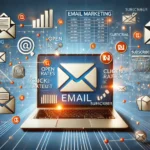In today’s fast-paced business environment, marketers have to navigate a plethora of strategies and tactics to effectively reach their target audience. Two dominant marketing approaches are digital marketing and traditional marketing. Understanding the key differences between these two strategies can help businesses choose the right approach to effectively engage their customers and achieve their marketing objectives.

Understanding Traditional Marketing
Traditional marketing refers to conventional methods of advertising that have been used for decades to reach customers. This includes print ads (newspapers, magazines), broadcast (television, radio), direct mail, billboards, and other offline channels. Traditional marketing often focuses on reaching a broad audience and relies on mass communication techniques.
Key Characteristics of Traditional Marketing:
- Tangible Materials: Traditional marketing often involves physical materials, such as brochures, flyers, and posters, which can be distributed to potential customers.
- One-Way Communication: It typically allows for one-way communication, where brands send messages without immediate feedback from consumers.
- Limited Analytics: Measuring the effectiveness of traditional marketing campaigns can be challenging. Metrics often rely on estimates and surveys.
- High Costs: Advertising through traditional media can be costly, especially in premium slots like TV or prime magazine placements.
Exploring Digital Marketing
Digital marketing, on the other hand, encompasses online marketing strategies and tactics that utilize digital channels to connect with consumers. This includes search engine optimization (SEO), social media marketing, email marketing, content marketing, and pay-per-click (PPC) advertising.
Key Characteristics of Digital Marketing:
- Interactive Engagement: Digital marketing enables two-way communication, allowing brands to engage with their audience in real time through comments, likes, and shares.
- Data-Driven Decisions: Digital marketing provides extensive analytics that enables businesses to track performance, measure ROI, and make data-driven adjustments to their strategies.
- Cost-Effectiveness: Digital marketing often proves to be more cost-effective compared to traditional marketing, allowing even small businesses to reach a global audience with limited budgets.
- Targeted Advertising: Digital marketing allows for highly targeted campaigns, enabling businesses to reach specific demographics based on behavior, interests, and location.
Key Differences Between Digital and Traditional Marketing
| Aspect | Traditional Marketing | Digital Marketing |
|---|---|---|
| Communication | One-way communication (broadcast) | Two-way communication (interactive) |
| Analytics | Limited tracking and metrics | Extensive data analytics and performance tracking |
| Cost | Often high (TV, print, billboards) | Generally lower (PPC, social media) |
| Targeting | Broad audience targeting | Precise audience targeting based on demographics |
| Engagement | Passive consumer engagement | Active consumer engagement |
| Adaptability | Slower to adapt to changes | Quick adjustments based on real-time data |
Which Marketing Strategy Should You Choose?
The choice between digital marketing and traditional marketing depends on various factors, including your target audience, budget, marketing goals, and industry.
- Target Audience: If your audience is primarily online, digital marketing may be more effective. Conversely, if your target market includes older demographics who prefer print or TV, traditional marketing could be beneficial.
- Budget: Small businesses may find digital marketing more accessible due to its cost-effectiveness. Traditional marketing can strain budgets with high upfront costs.
- Marketing Goals: For immediate results and brand awareness, digital marketing may be preferable. Traditional marketing can be effective for long-term brand building.
Integrating Both Approaches
In many cases, the most effective marketing strategy combines both digital and traditional marketing. This integrated approach allows businesses to reach a broader audience, utilize various channels, and capitalize on the strengths of each marketing method. For example, a business may use digital channels for engagement and immediate feedback while employing traditional methods to build brand recognition.
Examples of Integrated Marketing Campaigns
- QR Codes on Print Ads: Traditional print advertisements can include QR codes that direct consumers to digital content, such as websites or promotional offers.
- Social Media Campaigns with Offline Events: Businesses can promote offline events through social media platforms, encouraging online followers to participate in real-world experiences.
- Email Follow-ups for Offline Leads: Collecting contact information during offline interactions allows for targeted follow-up through digital channels, enhancing customer engagement.
Conclusion
Both digital marketing and traditional marketing have their unique advantages and challenges. By understanding the differences and similarities between these two approaches, businesses can create a comprehensive marketing strategy that effectively engages their audience and drives results. As the marketing landscape continues to evolve, staying informed about trends and best practices in both domains is essential for sustainable success.
In today’s competitive landscape, understanding the differences between digital marketing and traditional marketing is crucial for businesses aiming for success. Digital marketing encompasses various online strategies that leverage digital channels to connect with audiences. In contrast, traditional marketing relies on established offline methods to reach consumers.
Understanding Traditional Marketing
Traditional marketing includes techniques like print ads, TV commercials, and direct mail campaigns. It typically relies on one-way communication, meaning brands broadcast their messages without expecting immediate feedback. While traditional marketing can effectively build brand awareness, it often lacks the detailed analytics available in digital marketing.
Exploring Digital Marketing
Digital marketing includes strategies such as SEO, social media marketing, and content marketing. It allows businesses to engage in two-way communication with consumers, enabling them to receive feedback in real time. The ability to track analytics in digital marketing makes it easier to measure campaign performance and optimize strategies accordingly.
Key Differences Between Digital and Traditional Marketing
| Aspect | Traditional Marketing | Digital Marketing |
|---|---|---|
| Communication | One-way communication (broadcast) | Two-way communication (interactive) |
| Analytics | Limited tracking and metrics | Extensive data analytics and performance tracking |
| Cost | Often high (TV, print, billboards) | Generally lower (PPC, social media) |
| Targeting | Broad audience targeting | Precise audience targeting based on demographics |
| Engagement | Passive consumer engagement | Active consumer engagement |
| Adaptability | Slower to adapt to changes | Quick adjustments based on real-time data |
Conclusion
In conclusion, both digital marketing and traditional marketing have their distinct benefits. By understanding their differences and learning to integrate both approaches, businesses can create more effective marketing strategies that resonate with their audience.
In the digital age, businesses often find themselves torn between digital marketing and traditional marketing. Both approaches have their merits, but understanding the key differences between digital and traditional marketing strategies is essential for business success.
Understanding Traditional Marketing
Traditional marketing includes well-established methods such as print advertisements, television commercials, and direct mail campaigns. While these methods have proven effective over time, they often offer limited analytics compared to digital marketing, making it difficult to measure success. Furthermore, the audience targeting in traditional marketing tends to be broader and less precise.
Exploring Digital Marketing
Conversely, digital marketing encompasses strategies like search engine optimization (SEO), social media marketing, and email marketing. These tactics facilitate two-way communication, allowing businesses to interact with consumers and gather valuable feedback. The cost-effectiveness of digital marketing is evident, especially when compared to traditional marketing, which often involves significant expenses for ad placements.
Key Differences Between Digital and Traditional Marketing
| Aspect | Traditional Marketing | Digital Marketing |
|---|---|---|
| Communication | One-way communication (broadcast) | Two-way communication (interactive) |
| Analytics | Limited tracking and metrics | Extensive data analytics and performance tracking |
| Cost | Often high (TV, print, billboards) | Generally lower (PPC, social media) |
| Targeting | Broad audience targeting | Precise audience targeting based on demographics |
| Engagement | Passive consumer engagement | Active consumer engagement |
| Adaptability | Slower to adapt to changes | Quick adjustments based on real-time data |
Conclusion
Ultimately, choosing between digital marketing and traditional marketing depends on your business goals and audience preferences. By leveraging the strengths of both approaches, businesses can create comprehensive marketing strategies that effectively engage consumers and drive growth.
25 FAQs about Digital Marketing vs. Traditional Marketing
- What is digital marketing? Digital marketing refers to marketing efforts that use the internet and digital technologies to connect with consumers. This can include search engine optimization, social media marketing, email campaigns, and online advertising. Unlike traditional marketing, digital marketing allows businesses to reach audiences directly and interactively. The ability to analyze and adjust campaigns in real-time makes digital marketing particularly effective.
- What is traditional marketing? Traditional marketing involves conventional advertising methods such as print media, television, radio, and billboards. These methods have been in use for many years and focus on broadcasting messages to a wide audience. Traditional marketing often relies on physical materials, making it tangible but sometimes less adaptable than digital strategies. Measuring the impact of traditional marketing can be challenging compared to the detailed analytics available in digital marketing.
- What are the main differences between digital and traditional marketing? The primary differences include communication style, analytics capabilities, costs, and audience targeting. Digital marketing allows for two-way communication and provides extensive tracking capabilities. In contrast, traditional marketing often relies on one-way communication and offers limited data for measuring effectiveness. Additionally, digital marketing typically involves lower costs and allows for more precise targeting of specific audiences.
- Which marketing strategy is more cost-effective? Digital marketing is generally considered more cost-effective than traditional marketing. With digital strategies like pay-per-click advertising and social media campaigns, businesses can reach a broader audience with a smaller budget. Traditional marketing methods, such as TV and print ads, often involve significant upfront costs and ongoing expenses. Therefore, for many small businesses, digital marketing can provide a more efficient use of marketing resources.
- Can digital marketing replace traditional marketing? While digital marketing has gained prominence in recent years, it does not necessarily replace traditional marketing. Instead, businesses can benefit from integrating both strategies to maximize reach and engagement. For instance, a company might use digital marketing to engage with younger audiences while still employing traditional methods to reach older demographics who prefer print or television advertising. A hybrid approach can help brands optimize their marketing efforts.
- What role does analytics play in digital marketing? Analytics plays a crucial role in digital marketing as it provides insights into campaign performance, audience behavior, and overall effectiveness. Businesses can track metrics such as website traffic, conversion rates, and engagement levels in real-time. This data allows marketers to make informed decisions and adjust strategies for better outcomes. In contrast, traditional marketing often lacks the immediate and detailed analytics available in digital channels.
- How do businesses measure success in traditional marketing? Measuring success in traditional marketing can be challenging due to the limited tracking capabilities. Businesses often rely on surveys, feedback, and estimated reach to evaluate the effectiveness of their campaigns. They may also look at sales figures or brand awareness studies conducted before and after a campaign. While these methods can provide insights, they often lack the precision of digital marketing metrics.
- Which marketing strategy is better for small businesses? For small businesses, digital marketing is often the better choice due to its cost-effectiveness and ability to target specific audiences. Small businesses typically have limited budgets, making digital marketing more accessible and manageable. Strategies like social media marketing and content creation can generate significant engagement without the high costs associated with traditional advertising methods. However, depending on the target audience, a combination of both strategies may also be effective.
- What are some examples of digital marketing? Digital marketing encompasses a wide range of strategies, including search engine optimization (SEO), pay-per-click (PPC) advertising, content marketing, email marketing, and social media marketing. Each of these strategies aims to engage audiences online, driving traffic and conversions through digital channels. Companies can use these methods to connect with consumers, promote products, and enhance brand visibility in the digital landscape.
- What are some examples of traditional marketing? Traditional marketing includes methods such as print advertisements in newspapers and magazines, television and radio commercials, billboards, direct mail campaigns, and events or sponsorships. These techniques have been used for decades to build brand awareness and reach broad audiences. While they may lack the real-time feedback of digital marketing, traditional marketing can still effectively engage consumers, particularly those who prefer offline communication.
- How can businesses integrate digital and traditional marketing? Businesses can integrate digital and traditional marketing by creating campaigns that leverage both approaches to maximize reach and engagement. For example, print ads can include QR codes that link to digital content, encouraging users to interact online. Additionally, companies can promote offline events through social media platforms to drive participation. This integrated approach allows businesses to create a cohesive marketing strategy that engages audiences across multiple channels.
- What are the challenges of digital marketing? Digital marketing presents several challenges, including rapidly changing technology, increased competition, and the need for continuous adaptation to consumer behavior. Marketers must stay informed about the latest trends and best practices to remain competitive. Additionally, managing online reputation and addressing negative feedback in real time can be challenging. Despite these challenges, the benefits of digital marketing often outweigh the hurdles.
- What are the challenges of traditional marketing? Traditional marketing faces challenges such as high costs, limited targeting options, and difficulty in measuring success. Additionally, as consumer behavior shifts towards digital channels, traditional methods may become less effective. The one-way communication model also limits engagement with consumers, making it harder to build relationships. As a result, many businesses are exploring how to adapt their traditional strategies to remain relevant.
- How can businesses improve their digital marketing strategies? Businesses can improve their digital marketing strategies by regularly analyzing performance metrics, staying updated on industry trends, and continuously optimizing campaigns. Testing different strategies, such as A/B testing for emails or ad placements, can provide valuable insights into what resonates with audiences. Engaging with customers through social media and collecting feedback also helps refine strategies and create more effective marketing efforts.
- What skills are essential for a digital marketer? Essential skills for digital marketers include data analysis, content creation, social media management, search engine optimization (SEO), and email marketing. Marketers should also possess strong communication skills to effectively engage with audiences. Familiarity with digital tools and platforms, as well as the ability to adapt to new technologies, is crucial in the fast-paced digital marketing landscape.
- What are the benefits of digital marketing over traditional marketing? The benefits of digital marketing include cost-effectiveness, detailed analytics, and the ability to reach specific audiences with precision. Digital marketing allows businesses to engage in two-way communication, creating a more interactive experience for consumers. Additionally, the speed at which digital campaigns can be launched and adjusted provides marketers with greater flexibility. Overall, digital marketing often offers a more dynamic approach to reaching and engaging consumers.
- How does audience targeting differ in digital and traditional marketing? Audience targeting in digital marketing is more precise, allowing businesses to segment their audiences based on behavior, demographics, and interests. This enables marketers to deliver tailored messages that resonate with specific groups. In contrast, traditional marketing tends to reach a broader audience, making it less effective in addressing the needs and preferences of individual consumers. The ability to personalize content and messages is one of the key advantages of digital marketing.
- What trends are shaping the future of digital marketing? Trends shaping the future of digital marketing include increased use of artificial intelligence, automation, personalized marketing, and the rise of video content. Additionally, voice search optimization and influencer marketing are becoming increasingly important. As consumer behavior continues to evolve, businesses must adapt their strategies to stay relevant and effectively engage their audiences. Staying informed about these trends is essential for marketers looking to succeed in the digital landscape.
- How can traditional marketing still be relevant today? Traditional marketing can remain relevant by adapting to modern consumer preferences and incorporating digital elements. For example, businesses can use traditional methods to drive traffic to their online platforms or create integrated campaigns that leverage both approaches. Additionally, traditional marketing can effectively reach demographics that prefer offline communication, such as older consumers. Combining traditional and digital strategies can enhance overall marketing effectiveness.
- What industries benefit most from digital marketing? While digital marketing can benefit virtually any industry, sectors such as e-commerce, technology, and entertainment often see significant advantages. These industries thrive on online engagement, making digital strategies essential for reaching their target audiences. Additionally, industries like healthcare and education can leverage digital marketing to connect with consumers and provide valuable information. However, every industry can find ways to incorporate digital marketing into their overall strategies.
- What industries still rely heavily on traditional marketing? Industries such as real estate, automotive, and local services may still rely heavily on traditional marketing methods. These sectors often utilize print advertising, direct mail, and local TV or radio ads to reach specific demographics. Additionally, businesses targeting older consumers or those in less digital-friendly areas may find traditional marketing more effective. However, many industries are increasingly blending traditional methods with digital strategies.
- How can companies use social media effectively in their marketing? Companies can use social media effectively by engaging with their audience through regular content updates, responding to comments, and creating shareable content. Utilizing social media analytics can help businesses understand their audience better and tailor their strategies accordingly. Additionally, running targeted ads on social media platforms can enhance reach and engagement. Building a community around a brand on social media fosters loyalty and encourages word-of-mouth marketing.
- What is the role of content marketing in digital marketing? Content marketing plays a vital role in digital marketing by providing valuable, relevant content that attracts and engages target audiences. It helps establish a brand’s authority and expertise, driving traffic and conversions. Through various formats such as blogs, videos, and infographics, content marketing can enhance user experience and improve SEO performance. Ultimately, effective content marketing is key to building relationships and nurturing leads.
- How can businesses stay updated on digital marketing trends? Businesses can stay updated on digital marketing trends by following industry blogs, attending webinars, participating in online courses, and engaging with digital marketing communities. Networking with other professionals and leveraging social media platforms for industry news can also provide valuable insights. Staying informed about emerging tools, technologies, and best practices is essential for businesses to remain competitive in the evolving digital landscape.
- What future developments can we expect in digital marketing? Future developments in digital marketing may include further advancements in artificial intelligence, more personalized marketing experiences, and an increased focus on data privacy. Additionally, we may see growth in immersive technologies such as virtual and augmented reality, enhancing consumer engagement. As consumer preferences evolve, businesses will need to adapt their strategies accordingly, ensuring they remain relevant and effective in their marketing efforts.

















